1st LT Walter "Tiger" Thomas Mayberry, USMC Reserve, VMF-123 F4U-1 "Birdcage" Corsair Bureau Number 02351, March, 4th, 1944 Tunnel Hill Massacre near Rabaul Tamiya 1/48 Corsair
This is a true story about one of our local hometown "Daytona Beach" men, who went to War, and never made it back home.
His name was Walter Mayberry. He was a very gifted and talented "American" football player (not soccer
 ) who played professionally for the University of Florida as a "Gator". He was offered a full time position with the Rams, to play in the NFL.
) who played professionally for the University of Florida as a "Gator". He was offered a full time position with the Rams, to play in the NFL.Mayberry was a prominent running back for the University of Florida's Florida Gators football team. A triple-threat man, he also passed and punted. When punting he excelled at placing balls in the "coffin corner." As was typical in the 1930s, he played both offense and defense, posting multiple school records for interceptions. Mayberry was selected as a sixth round pick of the 1938 NFL Draft, but never played in the NFL. He was the first Gator drafted into the league.
"Tiger", as he was often called, set numerous football records that stood until the mid 1960's. He was at the time considered one of the greatest football athletes in the USA. They called him a "Triple Threat", because he could punt, pass, and run the ball better than anyone... and his stats prove it.
Instead of going professional as a full time football player, he opted to join the United States Marine Corps, where he became a F4F Wildcat, and later he transitioned into the F4U Corsair.
He flew with VMF-121, and then VMF-123 in the Solomon's campaign.
The narrative will have some descriptions of the atrocities that happened here, on the two separate days of March 4th / 5th, 1944, so viewer / reader discretion is advised. I'm not going into the brutal details of what actually happened, I'm going to keep it as clean and civil as possible, while still telling this tragic story as it really happened.
So please join me as I tell his story, and remember that freedom is not free. Our society today owes SO much to these men and women who often paid the ultimate sacrifice. Yet these memories fade as each day goes by... or they get erased.
I also want to specifically thank my fellow Corsair "Connoisseur" and friend Jim Sullivan @bentwing
for his help with some pictures of VMF-123. Thanks again Jim !
https://en.wikipedia.org/wiki/Walter_Mayberry
Here's a little more information listed on Wikipedia about Lt. Mayberry. It's not quite complete, but it gives you a good idea of just how gifted he was. It's not too long to read, and it will help give you a better understanding of this man.
One of our local hospitals put together a very nice memorial dedicated to the local men who lost their lives during WW2. I personally took these photos showing some of the monument to our local hero's.
"Tiger" Mayberry has also been listed with the rank of Captain on several websites, and even on his memorial at Halifax Hospital.
I do not know if he was promoted to this rank of Captain while in Japanese captivity, or if this is a typographical error. I would rather think he was actually promoted. I have also found several discrepancies with the various dates that are listed. I will try to sort this all out in the article for you.
As it turns out, during my research, I found out that both Mayberry and I attended the same school, although it was many years apart. He went to what was then called "Daytona High School. The school was built in 1925. The picture states the school's construction started in 1926, but I have personally seen the wall plaque at the our old school, at it definitely said 1925.
The school is no longer there. Eventually it was torn down in the late 1980's or early 1990's going from memory, and now there is a City "Votran" bus stop and Health Department building located on the site where the school once stood.
Mainland was still in operation when I attended, but it was now called Mainland 7th Grade Center. Ironically when I attended this school, there was a brand new TV show on the air called "Baa Baa Blacksheep" that stared Robert Conrad... but for me it was the Corsair that really made the show. My Dad and I used to watch it every week. Dad used to tell me how much they got wrong in the show... and boy was he right ! But we enjoyed the planes and had a good time watching it together. Now my Dad is gone, but I still have these fond memories with him.
One other interesting bit of information I found out here, is that "Tiger" actually BROKE HIS NECK and Severely injured his knee while practicing football on the football field at Mainland. Thank goodness he fully recovered. Even though I too have had my share of broken bones over the years, and other injuries, I still couldn't imagine going through something like that... they sure don't make 'em like this anymore do they ? Tough as nails and never quitter's.
Mayberry was born on March 14, 1915, in Daytona Beach, Florida, and attended Mainland High School in his hometown. His father Tom operated a small grocery store. His mother was Helena Marie Murphy of Lewiston, Maine. He played for the Mainland Buccaneers high school football team, and suffered a broken neck while playing.
Mayberry enlisted in the United States Navy Reserve at Atlanta on May 23, 1941, and was assigned to naval flight training. He transferred to Pensacola Naval Air Station as an aviation cadet near the end of 1941, and joined the United States Marine Corps Reserve as a fighter pilot on July 2, 1942.
He was later sent to San Francisco, and from there to the Pacific Theater of Operations to fight against enemy Japanese forces. Mayberry served with Marine fighter squadron VMF-121 and 123, flying F4F Wildcat and F4U Corsair fighter aircraft.
He was credited with shooting down three Japanese planes in battle over Vella Lavella Island; some sources also say it was four, with a fifth as probable kill. These two pictures above show what was written about him in September of 1943, a few days after he was shot down.
I was able to locate this awesome picture online. It shows several very prominent Marine Corp aces at "Cactus" Field which was the code name for Henderson Field on Guadalcanal. Here you can see Joe Foss in the middle. On the right side is John Smith. Both of these men would earn the Medal of Honor for their actions at Guadalcanal.
The fellow on the far left hand side looks suspiciously like Walter Mayberry. I am not 100 percent sure if it is, but it very well could be him.
If you compare this picture to these others I have posted of him, the similarities become even more evident.
About 10 years ago, our local newspaper the News Journal, wrote about Mayberry. These are some of the excerpts I was able to find online. Full credit goes to the News Journal for this information.
The man they are calling Major Richard Baker, was actually the Commander of VMF-123 at the time. I don't know exactly what Mayberry's total kill tally was, as it varies between 3 to 5 Zeros.
I personally took these pictures of the street sign with his name on it. To honor Mayberry and many of the other local men who gave all, we have streets that are named after them in this general area located by the Halifax Hospital.
Mayberry's street is located directly next to Halifax Hospital in Daytona Beach, Florida, near the Emergency Room entrance.
This is a condensed version of VMF-123's unit history in the Solomon's Campaign. They were the last Wildcat unit to transition into the new Corsairs that were arriving. They spent several weeks at Turtle Bay going through the familiarization and flight training process. Then they were officially the last Marine Corps Squadron to operate the Corsair during this time frame on Guadalcanal.
Here they mention some of the events that led up to Lt. Mayberry's final flight. They have the dates wrong. He was executed by the Japanese on the first day of the Tunnel Hill Massacre, which was on March 4th, 1944...exactly 79 years ago today, and the reason for the timing on todays posting..
This is another excerpt I got from the Pacific Wreck data base. It shows what happened on August 30th, and how Lt. Mayberry was shot down by a Japanese Zero near Fauro Island. From what I can tell, he drove off several Zero's off VMF-123 Commander's Corsair flown by Major Richard Baker.
At this time, Mayberry was attacked by another Zero, and he suffered damage to his engine. I'm not sure if he was able to successfully ditch the Corsair or not, as he could have bailed out. Some of the accounts I have read do indeed state he ditched. Either way, he ended up in the shark infested water for two days. Finally he was picked up by a Japanese boat, and taken to Rabaul.
This is where Fauro Island is located.
This is the Russell Islands. This was an advanced Allied airfield that had recently been captured by American Army and Marine Corps ground troops. Immediately within a day, half of VMF-123's Corsair complement was sent here to fly missions in support of the bombing runs that were being flown against "Fortress Rabaul".
This next photo shows the Munda Airfield. This is where the other half of VMF-123 was operating from at this time.
I am certain this is where Lt. Mayberry made his last Corsair take off flight from.
To further help you understand the geography of this area, here are some more pictures I took using Google Maps of the area. This shows the proximity of Fauro Island to Rabaul. Mayberry was shot down near Fauro Island.
This shows where Rabaul is located. The Japanese operated several airfields here. Some were Army bases, with the 68th and 78th Sentai, while others were used by the Imperial Japanese Navy. The IJN operated these units from Rabaul during this event.
201st Kokutai
204th Kokutai
Tainan Kokutai / 251 Kokutai
2nd Carrier Division with land based Zeros that were originally from the Junyo and Ryuho.
There were also two Japanese Bomber Fields in operation here. They had Mitsubishi G4M "Betty's", Nakajima "Irving" night fighters, and even some Ki-45 "Nicks" flying here as well.
This is the place where the Tunnel Hill Massacre occurred. This is a beach line setting, and it is about 1.5 miles from the tunnel where Mayberry and 29 other Allied POW's were being held inside a hollowed out man made cave. The cave was about 30 feet deep, maybe 2 or 3 feet wide, and roughly 5 to 6 feet tall.
From what I have read about this cave, it was tiny, cramped and always wet. It was dug out of the mountain rocks by forced labor. It was used to keep these prisoners held, and it only had a single door to guard. There were no windows, and it was always very dark inside. It doesn't sound like a nice place to be does it ?
There was not enough room for the men to lay down, and it was filthy inside. There was a single bucket that was used for toilet purposes. The men were let out on occasion. Some were allowed to work for the Japanese on various manual labor projects. Those that were well enough to work, did so, in order to escape for a little while from these horrible living conditions.
https://pacificwrecks.com/aircraft/f4u/02351.html
This is a link to where I obtained the information. There is a lot of great information here too. One thing that really caught my eye was a sworn affidavit, that was written by an Australian soldier who was also in captivity in Rabaul. Fortunately for him, he was not being housed in the "Tunnel Hill" location, or else he would not have survived either.
In this document, he wrote about a torture event he personally witnessed the Japanese commit against a fellow "Anglo" Prisoner of War. To keep it civil, they tied this poor man up, and poured boiling water over him, trying to get him to confess to something. The Australian soldier stated the screams could be heard everywhere. He also stated the process went on for a long time. It was brutal, but so is War.
I can ONLY imagine how horrible this must have been, either to witness or to personally endure. Keep in mind that Walter Mayberry was kept as a prisoner of War here from September 2nd, 1943, until the day he was executed by the Japanese on March 4th, 1944.
Here is what happened on the horrible days of March 4th and March 5th, 1944.
Around noon time, 15 Allied POW men, (including Mayberry), that were being held in the tunnel cave I described above were blindfolded, had their hands tied together, and forced to walk from the cave to the beach. The beach faced westward to Tailili Bay, and it was about a 1.5 mile distance.
At this time the Japanese executed these men right there on the beach. There were reports made after the war that some gunfire could be heard, but not much. This means that some of these men were likely beheaded or bayonetted to death. The lucky ones were shot or beheaded, because they likely wouldn't have suffered as much.
The dead bodies were left there overnight.
On the following day, March 5th, the rest of the remaining men from the cave, (15 in total), were given the same treatment. There were 22 Americans killed, and 8 Australians. I'm fairly certain these were all air crew members.
Rabaul was eventually bypassed, and allowed to "Wither on the Vine". After the War was over, the Japanese 6th Kempetai " Military Police Force" told the Allies that there were 30 Prisoners of War that were killed during a single Allied bombing attack on Rabaul. They gave the names of the 30 men who died, but the story didn't somehow sound right.
It is odd that all 30 men were killed, and none were wounded. So questions were asked...and eventually the truth came out.
It turns out the Japanese cremated these men's remains, and stored all the ashes in a single box which was then buried. The box containing the remains was recovered by the Allies, and they were equaled out in portions on how many bodies were estimated to have been contained in the box.
The Australians ended up with 25 percent of the ashes, and the Americans took home the remaining that was left.
These American ashes were then interred at the Jefferson Memorial Barracks Cemetery near St. Louis, Missouri. This picture above shows the memorial marker at Jefferson Barracks. You will see Walter Mayberry's name on the top upper right hand corner. Here again we see a conflicting date.
Lt. Mayberry was shot down on August 30th, 1943, and executed on March 4th, 1944. Here again his rank is also listed as a Lieutenant instead of a Captain.
Freedom is NOT free. Lest we forget.
We will never know for sure if Tiger is here or not, but at least he is not forgotten.
Ironically as it happens in War, none of the Japanese were ever held accountable for what they did here that is now known as the "Tunnel Hill Massacre". No one was ever prosecuted in General MacArthur's post war Japan for this particular War atrocity.
Many Japanese went into hiding for many years after the War ended, for obvious reasons.
However, for several years after the War had ended, it was estimated that somewhere between 4,000 to 5,000 Japanese were formally charged with War Crimes. Of these numbers, approximately 920 were eventually executed for their actions.
One other bit of information I uncovered is this sobering statistic about the differences between being held in a Japanese POW camp, or being held in a German Camp. If a person was held by the Japanese, there was a 40 percent chance they would die in captivity, while the number drops drastically to 1 percent if you were held by the Germans.
I'm not trying to down play what our men endured in the ETO or the MTO by any means. I'm only saying they had a much better chance of living until they were released when the war ended.
They all suffered horribly, in one way or another.
Ironically, some of these Japanese war criminals were set free after serving only a portion of their sentences several years later. This was around the time when the Korean War was getting "hot", and MacArthur wanted to use the Japanese for help on the UN side.
Remember when I said that Jim Sullivan was kind enough to share some information with me about VMF-123 ?
He sent me this picture, along with some others. This got me into a deep dig, and I eventually found another picture that was located in the Marine Corps historical photo section.
It turns out, these are actually part of the same series of photos that were taken at the same time. These last two have been cropped at some point down the line. These pictures show VMF-123 Corsairs on September 7th, 1943. This is exactly one week after Lt. Walt Mayberry was shot down, and just as he was entering his living hell in Japanese captivity.
In another book, that was written by Michael John Claringbould on Pacific Profiles Volume 4, Corsair units in the Solomon's 1943-1944, he lists the numbers on the sides of these aircraft. These were shown as the known fuselage numbers being #36, 37, 79, 98, 101, 104, 111, and 114.
Some of these numbers are clearly visible here.
Mr. Claringbould also stated that VMF-123 most often used the last two digits of the Corsair's Bureau Number on the side of the fuselage for identification purposes. However, on occasion, they received "hand me down" Corsairs, and they retained the original numbers that were on the side of the plane and on the front of the landing gear doors. There was no set standard, and I took the liberty to make Mayberry's Corsair as #51.
I do not know if my #51 markings are 100 percent authentic, but it is plausible.
Going on to the model now:
This is a Tamiya 1/48 "Birdcage Corsair. I recently built it, along with a VMF-214 George Ashmun Corsair. There is a build journal as part of the Pacific group.
This is an "almost" out of the box build, and it is based on a very early Vought Corsair, Bureau Number 02351. It turns out this was only the 199th Corsair that Vought had built to date. It is also the same plane that Walt Mayberry was shot down in. Since it is an early Corsair, I made some slight modifications. I'll explain.
I modified the cowling flaps. On these early Corsairs, like the one Mayberry was shot down in, the engine cooling flaps would open all the way around. On the early Corsairs, these were hydraulically operated. This caused oil to spray onto the pilot's windshield. So they were soon modified, and the top three flaps were eventually sealed up.
You can see how these upper flaps are secured in the "down" position in the original VMF-123 pictures I posted above.
These "early" Corsairs did not have a head rest.
You can also see the missing headrest in the "Find A Grave" photo where Mayberry is standing next to a Corsair, while chomping on a cigar. Here again you can see another incorrect date of death listed.
The early Corsairs had a flat canopy, top, one that didn't have the rear view mirror bubble installed. However, Vought manufactured an additional 300 "improved" mirror style canopies, and shipped them out to be replaced in the field.
So I opted to install a newer canopy on his plane. Originally though, it would have had a flat style top on it and no small bubble.
The leading edge of the wing had a wooden stall strip added on the later versions. This was done to help both wings to "stall" at the same time. It was not present on the early Corsairs, but here again it could have been added in the field. I took the liberty to keep it off this one.
These Corsairs often had exhaust leaks that were visible with exhaust stains on the sides of the fuselage. I used a Tamiya weathering deck to simulate this. Since they were being operated from coral runways, the back sides of the propellers and leading edges took a beating from the coral dust as it was being blown around by the prop wash while on the ground. I'm not 100 percent happy with the back of this prop, so I recently picked up some "rub-n-buff" to see if it will make it look a little more even.
These Corsairs also had regular touch up painting done as it was possible. I tried to replicate these effects too.
In addition to painting over the previous fuselage numbers, I also gave the engine cowling the same treatment. Here I used a slightly more bluish shade to give the appearance of a fresher paint that what is surrounding it.
Fuel was frequently spilled on the fuselage. It actually became a problem, and numerous Corsairs were lost to ground fires, when the engine was initially started up within an hour or so after fueling operations were done. This is why we often see tape on the upper fuselage decks in later pictures.
The fuel vapors would collect here and ignite when a spark was present.
I painted a small area on the side of the fuselage to make it look as if a previous fuselage number was painted over, and then a new #51 applied in it's place. Some of these planes were handed down from other units in the area as new ones were being delivered.
During my exhaustive research on this story, I ran across a short video clip that was part of "Oliver North War Stories". This episode was about the Blacksheep. As luck would have it, I stumbled across this "Birdcage" Corsair in the video clip as it aired on TV. I had to pause it, and I took this picture.
Here we can see a Corsair, wearing a #51. I do not know what unit it is from. It also has the correct "red" outline around the wing portions of the US insignia that were in use during this time in 1943. You will also see the top cowling flaps are secured down. Mine were modified and built in the open position.
One other thing is this Corsair does not have the US markings in all four locations on the wings. You can clearly see the lower underside of the Port wing is clear of US stars.
Could this actually be Mayberry's plane ?
You decide...
It could be. If so, I didn't get it exactly right. But, these planes went through an evolution of markings, so I guess it could be possible I got it right in theory. Only to have a working time machine...
I used some chalk and Tamiya weathering decks to make it look dirty near the ammuntion boxes and on top of the wing mounted .050 MG's.
I tried to make it look as if the plane was flying overhead here.
Notice the oil stains and dirt oil / engine filth.
This is a nice point of view. The landing gear legs were a bit wobbly, so they look a tad crooked in some pictures. Maybe it was an optical "delusion"

On some of these Corsairs that flew here, they operated during a transitional period, where the US Star insignia style was changed. Notice how this Corsair has the 4 original Round Star style insignia from 1942, and how the "wings" were simply added as an after thought. Eventually these would have possibly been painted with an outline of Blue or possibly Red. Red was not very welcomed by the Americans in the Pacific, as the color could (and occasionally was) mistaken for Japanese markings.
I know this is a very long article. I want to thank you for reading it in it's entirety.
As always, comments are encouraged.
Thanks for stopping by.










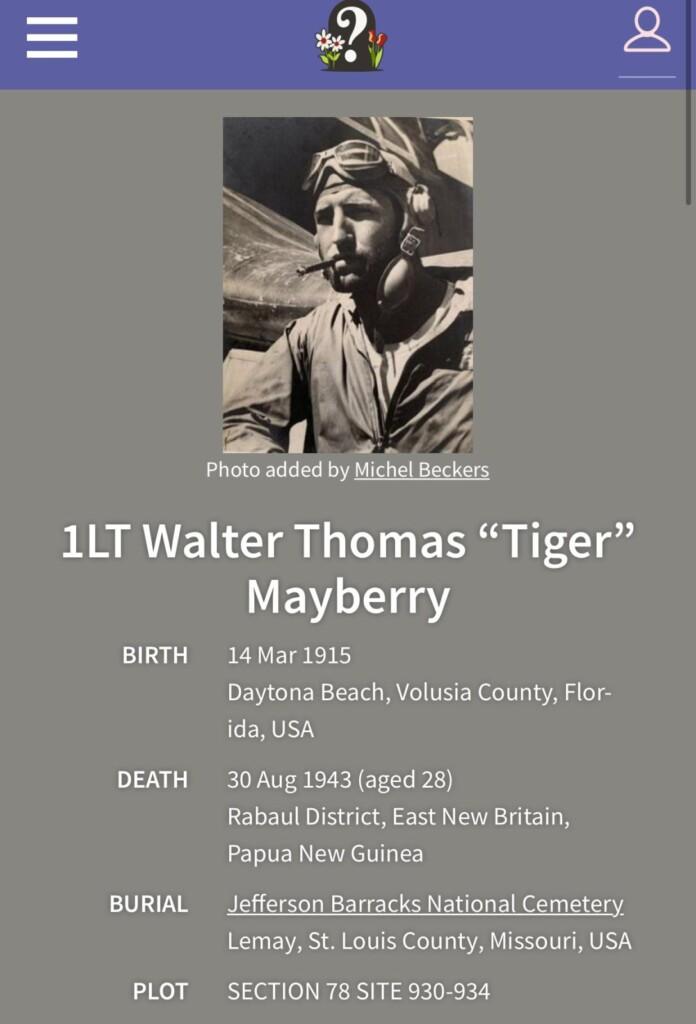





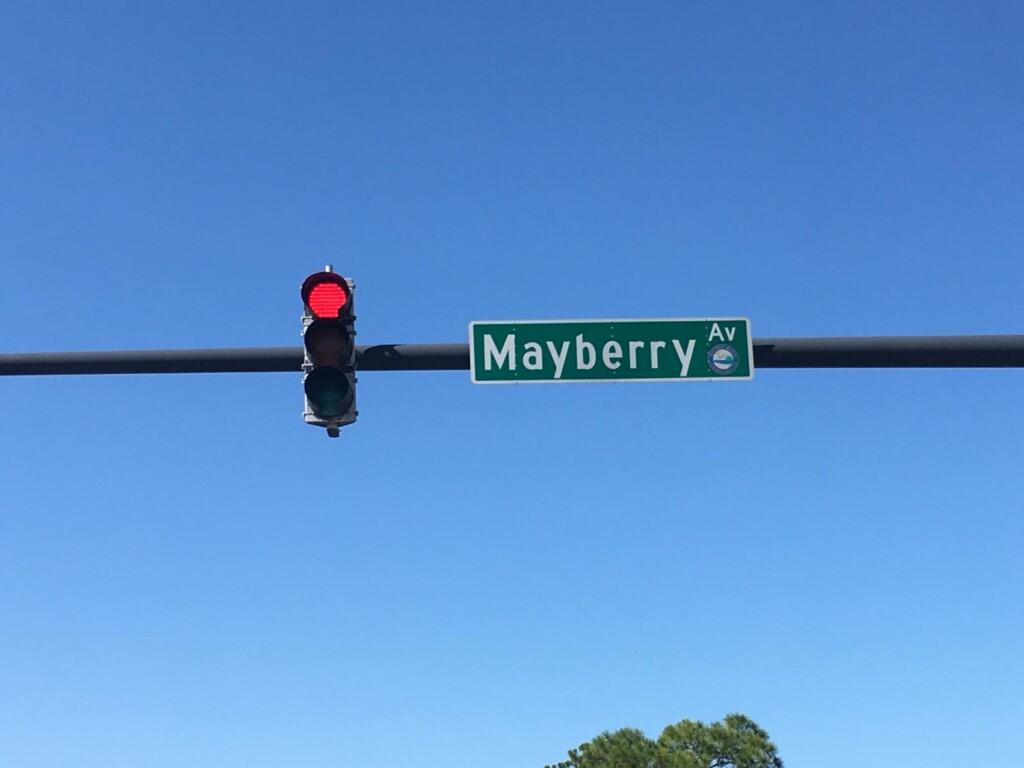




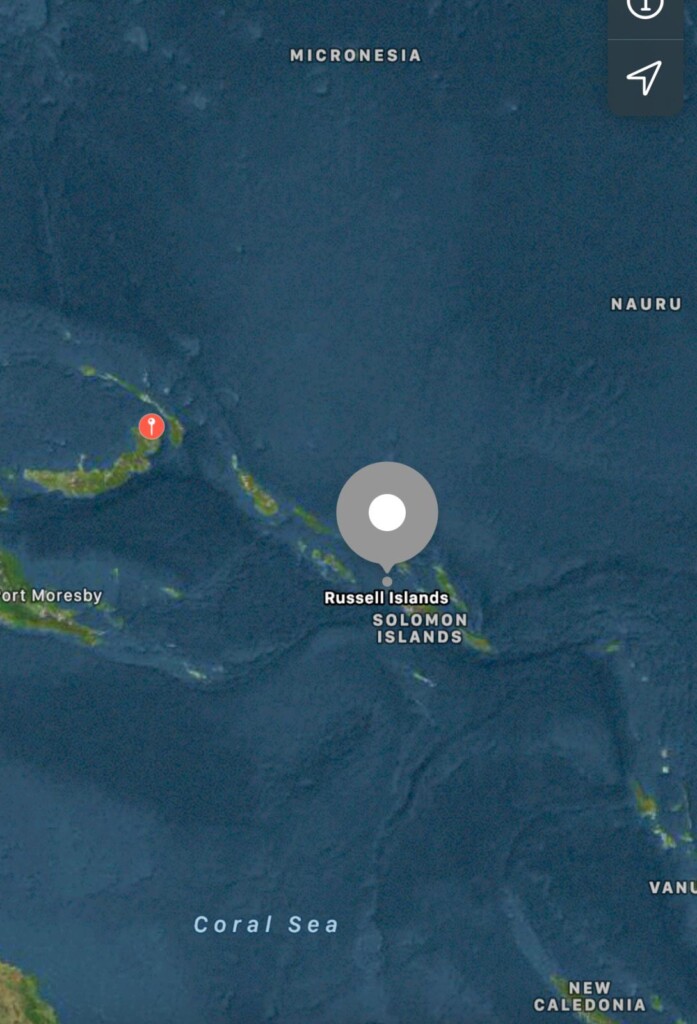




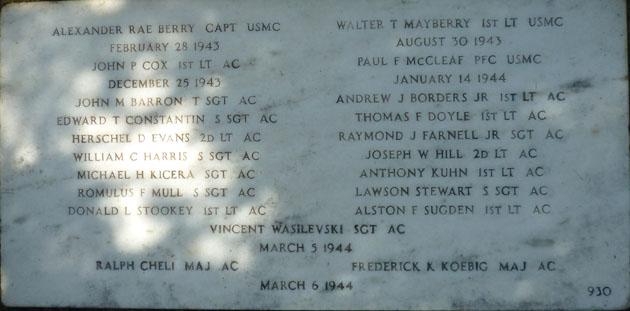






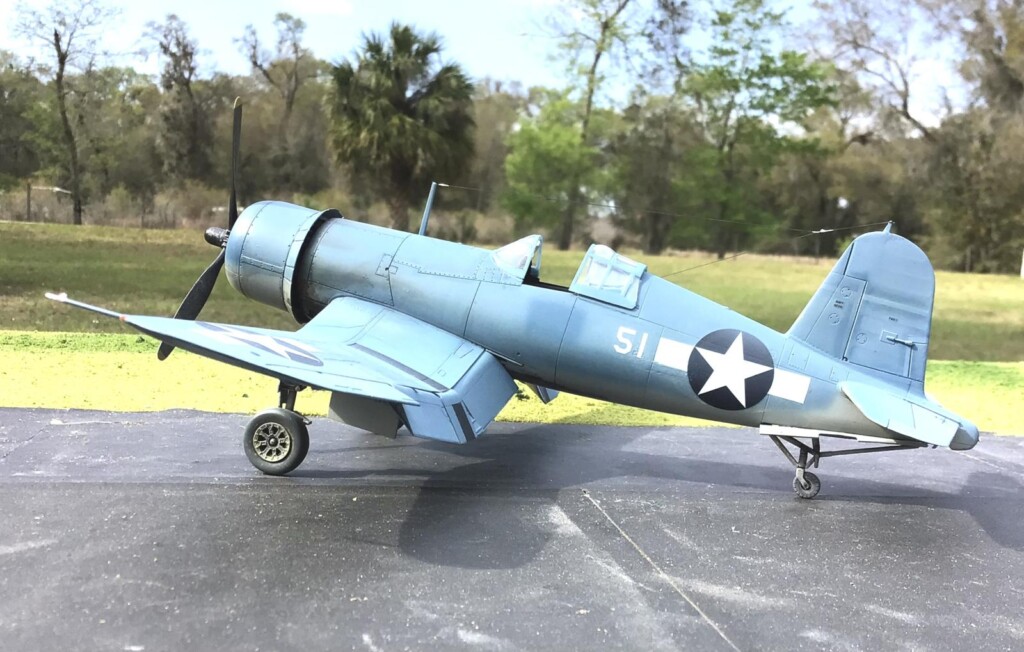
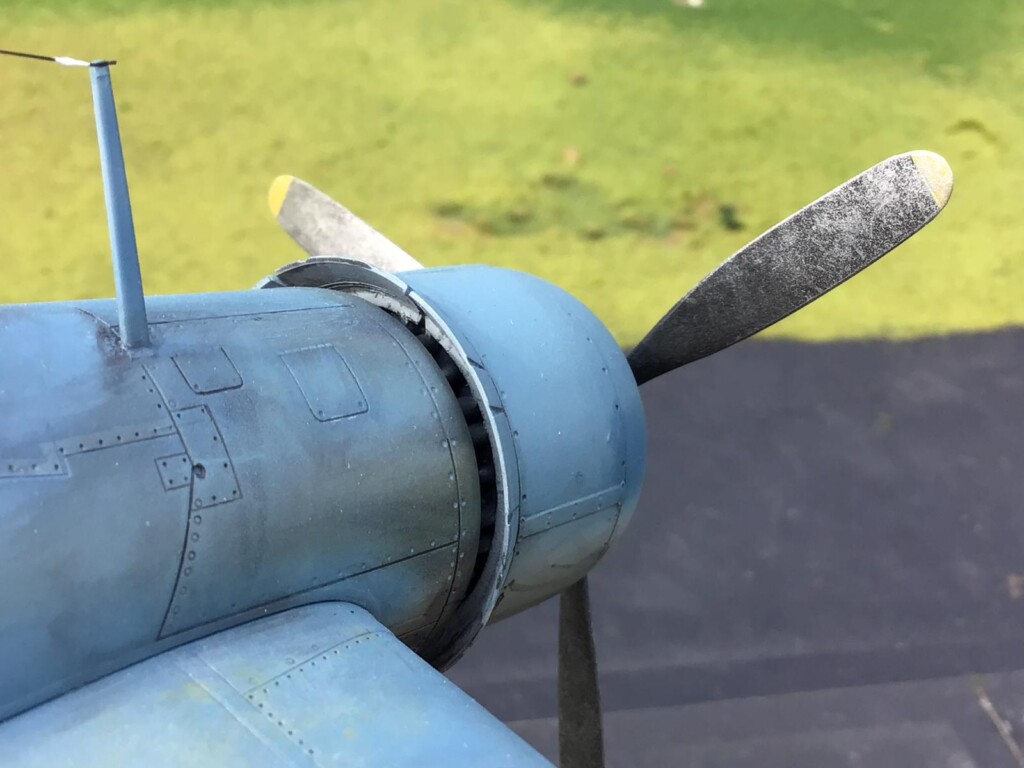





















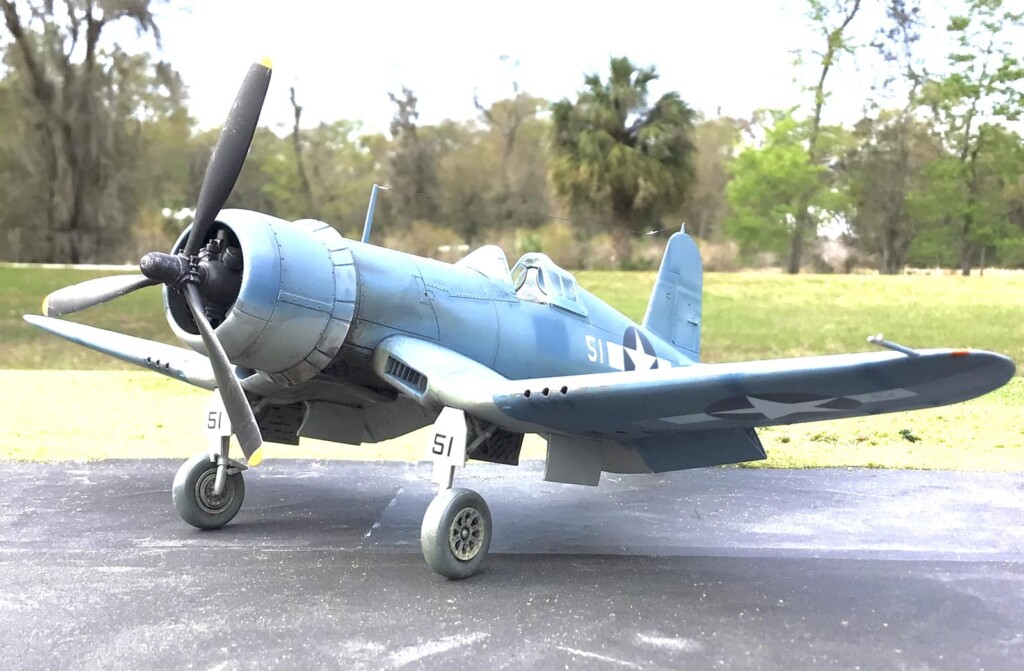






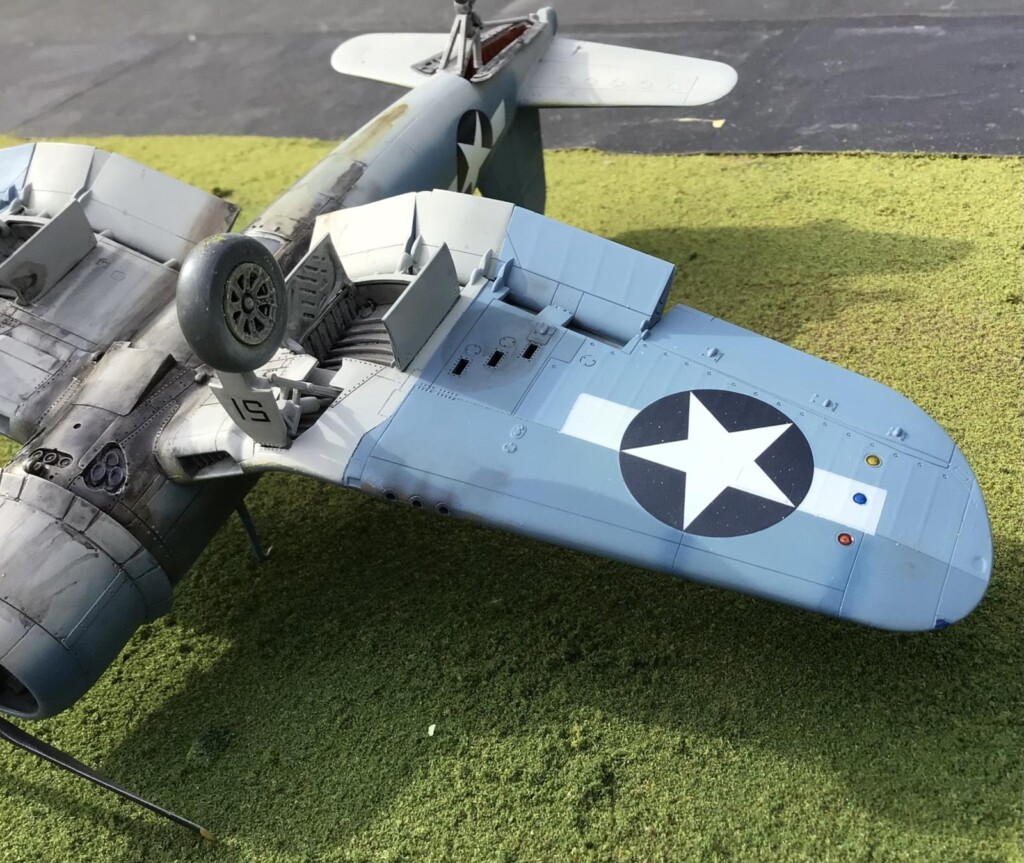


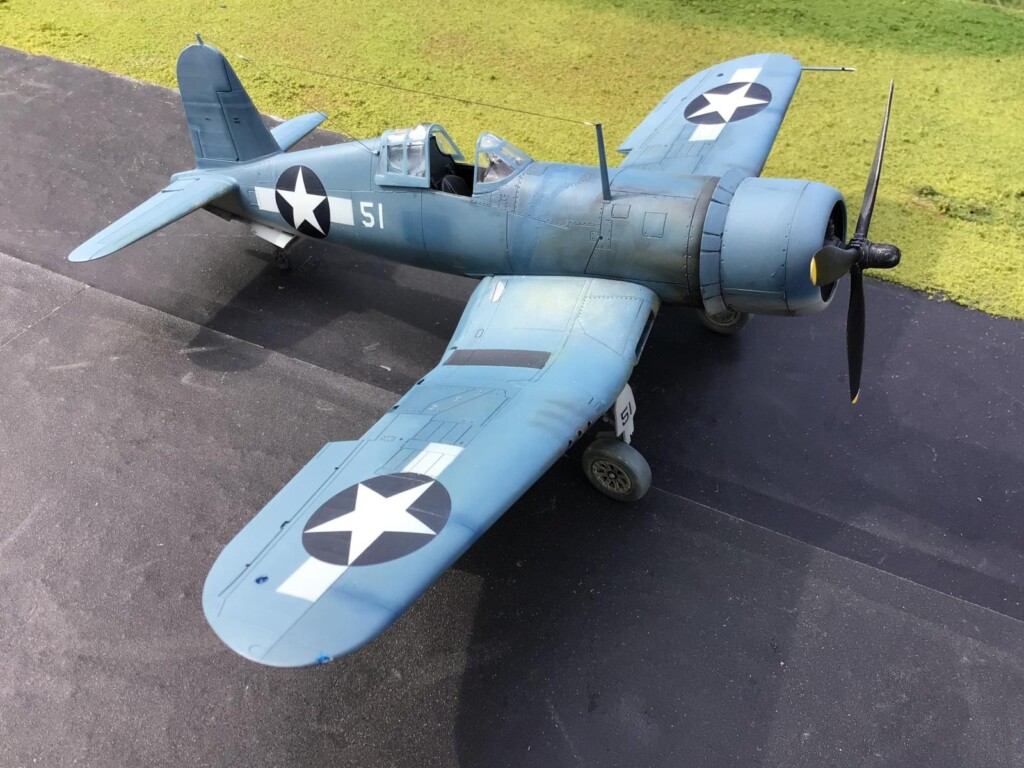


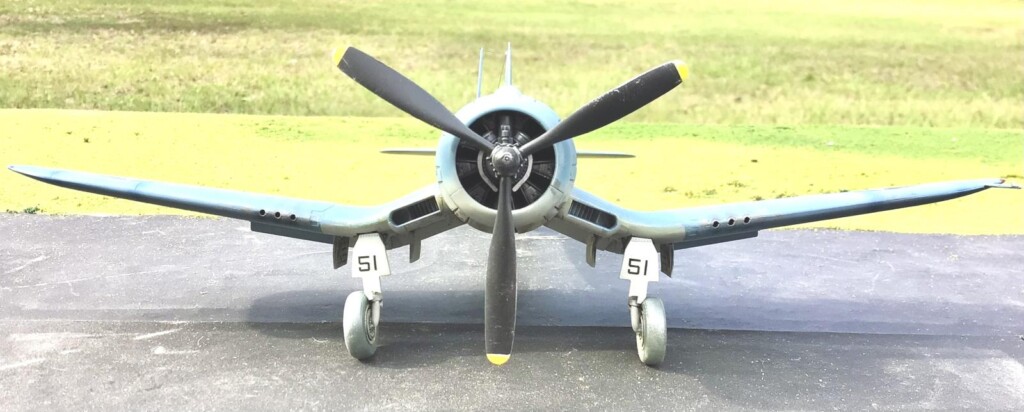


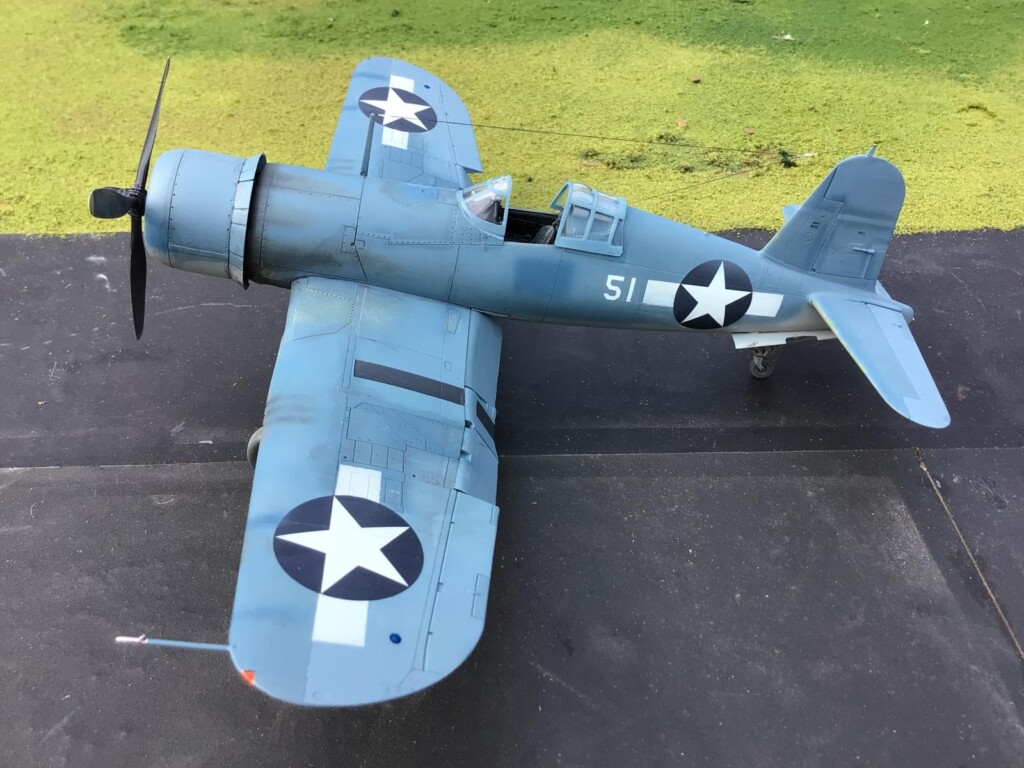












What a wonderful bird @lgardner! Thanks for sharing this story and build, good to see you here time and time again!
Michel Verschuere (@michel-verschuere)
Thank you Michel ! It's always nice to hear from you, and I sincerely appreciate the kind words. Please say hello to your family for us.
Absolutely fabulous paintwork @lgardner and best regards back from across the pond! The Free West always prevails!
Michel Verschuere (@michel-verschuere)
Yes Sir it does ! Thanks again my friend. Take care brother and stay safe.
Interesting story and great build!
Lis (@lis)
Thanks Bernard. I was pleased to build it for your Pacific Group. The George Ashmun Corsair is also now completed, so it too will end up in the headlines section one of these days.
An amazing build, my friend Louis! And an equally amazing story! Freedom is definitely not free. The Ones who offered their lives must not be forgotten.
Spiros Pendedekas (@fiveten)
I sincerely appreciate the kind words you said about this article. I actually happened across this memorial we have at one of our local hospitals by accident. We were there one day as my wife was being treated for her cancer. I saw a glass display case, and inside was a bronze or pewter style bust of Mayberry, and it said "Corsair Pilot". That's all it took to get the wheels turning.
Then I knew right there someday I would do this build, and try my best to get his story out.
There are still quite a few more men who were killed from our area that do not have any such honors. In fact many of these names you can see on the wall memorial don't even have a picture of the person, only their name and events that surrounded their deaths. What is even more saddening, is that quite a few of these men on the wall died in captivity in Japanese POW camps. I have read that there was a 40 percent death rate in a Japanese camp, verses a 1 percent rate in a German one.
This is so tragic and sad.
I hope to someday continue on with building up a few more aircraft that some of these Patriots met their untimely demise in.
Thank you again my friend. Take care.
For historical perspective, the Germans are, and have been, for better and for worse, an integral component of Western Civilization and as such, were much more keen to avoid blatant violations of the Geneva Convention concerning POWs (with the possible exception of Soviets); they too had prisoners in Allied POW camps and certainly wanted to avoid retributive acts to their own resulting from mistreatment of their prisoners.
The Japanese, on the other hand, were not part of Western Civilization and did not share in those cultural mores; they were not signatories to the Geneva Convention, believing that surrender was an indication of personal cowardice and that combatants either achieved victory or death with honor. In their eyes, those who surrendered deserved to suffer death without honor.
A magnum opus on your part, Louis- we appreciate the depth of research honoring Tiger Mayberry. Respect to all here who served.
George Akin (@george_akin)
I believe what you have written here is spot on... and I sincerely thank you for the compliments.
The more I dug into his story, the more I felt it was my duty to tell it as it needed to be told. Truthfully and respectfully.
Take care.
Superb all round Louis. It's down to younger generations to make sure their sacrifices do not fade. Thank you for your build and narrative.
guy barker (@thom)
Thank you for the kind words on this story. It had a very personal meaning to me for several reasons, some of which is the local connection with my home town. Like you, I feel that if we do not continue to "carry the torch" for these heroes, they will someday end up forgotten. And that is something I don't want to happen. If it does, then everything they endured and believed in is lost forever. We have a way of forgetting our past, be it good or bad, intentional or accidental.
Thanks again.
Louis! What a marvelous tribute. Your build definitely does justice to honor this Marine aviator. Well done on all.
gary sausmikat (@gwskat)
Thanks Gary !
This one was extra special to me. I wanted to get his story out there, and build a tribute model in his honor at the same time. He was one of our local men, and his story is one that I wanted to share with others.
There will be more like this coming up, (the Good Lord willing that is).
Thanks again for stopping by, and especially for commenting. This means a lot to me.
Take care buddy.
Lou,
You put in a 110 percent on this one. Excellent article and build . I have read the article several times and the Corsair made for this article raises the bar for us mortals. With nine more ladies waiting in the wings how you manage to build them and focus one model for this article say's a lot about motivation and honoring our nations hero's who sacrificed for Democracy.
Looking forward to your next modeling project/projects.
Smashed the like button.
Stephen W Towle (@stephen-w-towle)
Hey Stephen,
First off, I want to thank you for your comments and compliments on this. It seems that when there is more of a personal connection, that we tend to put more effort into a project. I mentioned to Spiros in my reply to him above, that my wife and I accidentally stumbled into this veterans monument one day quite chance.
She was there for another round of her chemotherapy treatment for her fight with cancer a little over 3 years ago. I saw a small glass display case in one of the hallways inside the hospital, that was overlooking the monument that was sitting just outside. The display case had a metal bust of Mayberry inside and it said "Corsair pilot".
Then my eyes were drawn to look out through the windows, and I saw the monument that was sitting outside. I always knew from that point on, that I would come back at a later time and pick up the ball and run with it.
This is the end result. I spent a lot of time doing research on him, and the more I dug into his past, the more I found we had in common.
This is also part of the reason why I have not been working on the "LOU IV" Mustang. But fear not, "I shall return !"
Thanks again, and I will stop in to check on your Mustang progress soon. I have been watching the updates, I simply have not had much free time lately.
Nice see you posting a new model Louis, and in your usual comprehensive style too! Great story and splendid Corsair. I especially like the worn effects in the propeller blades and the very heavy staining of the undersides. Thumbs up mate @lgardner
Pedro L. Rocha (@holzhamer)
Hello again my friend ! It's always great to hear from you. Thank you for the kind words. These Corsairs (and most aircraft in the Pacific) were often kept in service with the bare minimum maintenance that was needed. Things like washing or touch up painting often took a back seat to keeping them flying and the weapons working. The harsh coral strips they flew from chewed the paint off the back sides of the propeller blades, and also wrecked havoc on the leading edges of the aircraft, particularly where the prop wash would hit on the plane.
Since I have posted this article, I tried something new. I picked up a tube of stuff called "Rub-N-Buff" and it's available in different metallic colors. I got one for a silver color, and I rubbed some on the back of the prop blades. It made a huge difference, and now I think you would like it even better.
Here's a picture for you to show the difference now.
Thanks again !
PS: I still have not forgotten about our Mustangs. or the Dornier 17Z (which I was looking at earlier today).
or the Dornier 17Z (which I was looking at earlier today).
If we only had 27 hours in a day...
Those back side blades show indeed a highly realistic worn finish @lgardner
That Rub-n-buff product you used, is that a paste or a powder of sorts, similar to the old SNJ?
Pedro L. Rocha (@holzhamer)
It’s a paste and it comes in a little tube.
Be careful though when you first open it up. You have to puncture the tip of the tube. When you do get ready for some of the material to come out.
It takes just a super tiny amount and it covers well. The more you rub on it, then the shinier it will become.
It’s also available in different colors. The one I have is called Silver Leaf, but the sample in the picture I provided is called Antique Gold.
The instructions say it can be cleaned up or removed using acetone. I used turpentine. If you spray acrylics, you would probably want to seal it just in case. I still use enamels, so it worked out OK for me.
Hope this helps my friend.
Thanks again.
27 hours a day?
STILL wouldn't be enough, BFAM!
@lgardner
Jeff Bailey (@mikegolf)
I fear you are correct with this statement.
BFAM, I would need more like 48 hours in a day.
Hi Louis, maybe you don’t post quite so often these days, but, man, when you do, you knock it for six. Such a well researched article and a beautiful model of a Corsair to boot. Definitely liked. Interestingly, we were recently served frozen mayberries at a local restaurant.
George Williams (@chinesegeorge)
Hello George.
I must agree with you, I have not been posting too much in the headlines section lately. We have been through a lengthy illness and it has taken a toll on my wife and I. Covid... hate it. Don't worry as we are good now.
I sincerely appreciate the kind words. This one had a very personal meaning for me, since Mayberry was one of the local men who didn't come home. He flew my favorite plane too, and we went to the same school although it was many years apart. Chances are we walked in the same places too.
I don't know how to describe this, but it was something I just felt like I had to do. You can look at some of the comments I left for Spiros and Stephen T. above. This shows how my wife and I accidentally stumbled across this monument at one of our local hospitals.
Speaking of Berry's... This morning I had a few waffles, with Blueberry's on them. My favorite !
Take care friend, and stay safe.
Great build! Thanks for sharing your work and research.
David Butler (@dbutlr)
Thank you ! It was my pleasure, and I'm glad you enjoyed it.
Really nice work on the model @lgardner and great research on the subject matter.
You made a very important point about the lack of punishment of Japanese for war crimes by MacArthur. the only Japanese he went after as a war criminal wasn't a war criminal - he was General Yamashita who had the insouciance to make a fool of the "Great Genius" MacArthur by defeating him in the Philippines in 1942. So MacArthur had him tried as a war criminal for "war crimes" committed by the Imperial Army in the battle of Manila in 1945 - when Yamashita, as the commander, had no contact with his troops.
In Japan, MacArthur was the New Shogun after the war, and did nothing to "de-imperialize" the Japanese the way the Germans were "de-Nazified." In fact, several of the wartime leaders were among the "new" leaders of the "Liberal" "Democratic" Party (which has never been "liberal" or "democratic" in the 70 years since) founded to run the country after the peace treaty was signed in 1951. Today you can still have a Japanese tell you the "history" of World War II they learn in school: "We went to war to liberate Asia from the Imperialist Whites, and we won every battle, but had to make strategic retreats, and then - atom bombs!" There has never been a Japanese official who recognized the war crimes of the Bataan Death March, the Rape of Nanking, the Malayan Railway ("The Bridge on the Riover Kwai"), or the "medical experiments" of Unit 719 - unlike what the Germans had to do.
(Yes, as an historian I am no fan of America's most over-rated i d i o t in uniform - as Eisenhower said of him "I learned all about acting when I served under General MacArthur") As was said of him by those who knew him best, he was either great or terrible (about 1 point great to 5 points terrible) with nothing in between.
Tom Cleaver (@tcinla)
Hey Tom
Thanks for the detailed reply. I think I should go back and add a little bit more information on how no one was ever indicted on charges for this particular war crime. These 30 men were killed and no one was ever held accountable for it.
I think now, after looking back how I had it written, it could lead some into thinking that none of the Japanese were ever prosecuted, and that's not true.
It turns out that well over 4,000 to 5,000 Japanese were actually tried and convicted of War Crimes in the years following WW2. Of this number, around 920 of them were indeed executed.
I took a few screen shots showing what I found, in an effort to help clear things up.
One other bit of information I found reveals statistically just how bad it was for POW's in Japanese captivity, versus those who were held in Germany.
I'm not trying to downplay what our men in the ETO and MTO went through by any means. They all suffered, in some form or another.
I met one of my Dad's childhood friends once. He was a top turret gunner in a B-24 named "Chief" and he flew with the 98th BG and went to Ploesti several times.
He was shot down and captured on September 3rd, 1943, and held in various Luft-Stalag camps until he was liberated by the Brits in 1945. When he was freed, he only weighed 85 pounds and didn't have shoes.
Thanks again for your insight. I sincerely appreciate this.
Take care.
Tom Cleaver (@tcinla)
OK I just edited the article to reflect what I mentioned above in my last reply to you.
It reads better now, and makes more sense.
Thanks
Yes, a very good revision.
I should also say that what irks me is that the "big criminals" appear to have been left alone, unlike what happened in Germany where the top criminals were the ones who went into the dock first. People like the drunken Japanese officers who took FAA pilot Sub Lt Fred Hockney - the last Allied POW to be the victim of a war crime when they took him out the night of August 15, 1945, and beheaded him and hid the body - were arrested, tried and executed; in fact other Japanese were the ones who turned them in to the Allies. But the ones who planned the war? The ones who taught young men to think like those young officers? They were never touched.
Tom Cleaver (@tcinla)
You bring up some very valid points. I think a lot of this had to do with the facts that the Japanese wanted to "keep" Hirohito in charge, as part of the "so called" unconditional surrender... you know, when they had to "endure the unbearable", since surrender wasn't in the vocabulary then.
I think the Allies knew it would be a blood bath had they committed to "X Day" in Japan. Ironically, the United States ordered a huge supply of Purple Heart medals in preparation for this. They are still being issued to our troops today, from the same batch. I have read somewhere they ordered something close to 4 MILLION of them.
So in order to have peace, we agreed to allow Hirohito as the head of state. This allowed the Japanese to save face, and it also ended the war. Many Japanese were shocked to find out their Emperor was a real human being. He had been portrayed as a God figure before.
Most didn't recognize (or understand) what he stated in his radio announcement when he stated to the population the War was over. He spoke in a different dialect of Japanese, one that was more "proper" and less understood.
However, like you, I am also very surprised that the higher echelons were not prosecuted as they were in Germany. There had to be more to it...
Thanks again.
Agreed!
Louis,
Home run all the way around on this build. The story of Tiger Mayberry is one I’ve never heard before. Thanks for sharing.
The paint work on this Corsair is some of the best “in-theater” looking paint I’ve seen. Great work.
Matt Minnichsoffer (@coondog)
Thanks Matt ! I wanted to get Tiger's story out there. He is one of the many who went down this path to destiny. Since he was from my home town, (or the other way around), it had more of a personal meaning to it.
These Solomon's Corsairs took a beating in the environment they operated in. I wanted to try several new techniques out, and I used some of them again on the VMF-214 George Ashmun Corsair.
It too will have a similar appearance, but enough to keep it interesting and different enough not to be a duplicate. Same church, different pew.
Thanks again Matt. I'm looking forward to seeing your Preddy Mustang in the headlines section. It's really sharp !
Very nice historical background of Mayberry, Louis @lgardner
Your build is a perfect replica of Tiger's aircraft.
It was a pleasure to follow your thread and read about all the research done.
John vd Biggelaar (@johnb)
Thank you John for several things, including following along with the build journal. I sincerely appreciate your feedback. You frequently comment on my build journals, but lately I have not been commenting too much on anyone's journals. It's not intentional, I just don't have much spare time lately. I will try to get better with this. I have been watching your mutual Mustang builds and you have been doing some marvelous work. I will try my best to become more visible again.
This project had a very personal meaning to me. Thank you for everything. You are a true friend.
most excellent background and build Louis !
Paul E. Owens (@ramair67)
Thanks Paul. I sincerely appreciate your comments.
Hi Louis. Awesome Corsair, awesome article! Could you please let us know how you did the top cowl flaps modification? I always liked the look of these early corsairs with the full-circumference cowl flaps. Thanks, Louis!
Nick P (@misfitnick)
Thanks for the kind words. The cowling flaps were made by using a spare set of the open flaps I saved from a previous Tamiya build. I had an extra set of the open style left over, because on one of my other previous Tamiya Corsairs, I had built it with the cowling flaps all closed.
It was simply a matter of cutting away a small portion of the top ring on the open flap set where the three upper flaps are molded in the down or closed position. Then I cut off the three flaps from the spare part and glued them in. Here are some pictures.
Hope this helps. Also this will make the back side of the exhausts and intake manifold pipes a lot more visible, so you will want to paint them up accordingly.
You will also have to use caution when fitting these parts in place. The engine is held in place by the flap ring, and I had to open mine up so I could slide the engine into the cowling. I took some time to make sure the engine was centered into the cowling afterwards.
Take care.
Great model and great story, Louis (@lgardner). Finish on the model looks perfect. I can't imagine how much time it took to assemble all of the info and pictures for this story. Great job.
George R Blair Jr (@gblair)
Thank you George. You can tell this one here was extra special to me, for numerous reasons. It has been a long time in the making. I have been working on and off on the research part for a little over 3 years now. My wife and I accidentally stumbled into this quite by accident one day while she was going to the hospital for another round of chemotherapy as part of her cancer treatments she that went through.
The actual building part didn't take too long. The painting and weathering part was another story. I was building this one and the George Ashmun VMF-214 Corsair at the same time. It didn't help that I was recovering (or trying to it seemed on occasion) from a fairly long fight with Covid.
But in the end, we prevailed, and I completed my mission.
Thanks for stopping by, and for all of your support with various projects over the years. You're a good man, and even better friend.
Take care brother. Stay safe (and take it easy please).
Maybe you should take a shot at expanding this into a book, after all, you have already done a bunch of research. :o)
George R Blair Jr (@gblair)
Hmmm. Where there's smoke, there's fire.
I'm struggling to build as many of my models as I can, but you just never know.
Thanks again !
Incredible article Louis @lgardner! Your model and research are both fantastic, and both are the result of lot's of hard work! Very impressive entry Louis, well done my friend!
Your model and research are both fantastic, and both are the result of lot's of hard work! Very impressive entry Louis, well done my friend! 
Gary Brantley (@garybrantley)
Thanks Gary. I sincerely appreciate your kind words and compliments. This one was a build that took on a very special meaning for me, for a lot of reasons. It's really hard to describe it to be honest. It just seemed like it was something that I HAD to do. I don't know why... Maybe sort of like the Kevin Costner movie "Field of Dreams" ? Don't really know for sure, but I'm VERY happy it turned out like it did.
Freedom is not free. Here's proof.
Thanks again buddy. It's great to hear from you.
What a great post! A superb model and a fascinating history to go with it. Well done!
Chas Bunch (@chasbunch)
Thank you for stopping by and especially for leaving these wonderful comments. I am pleased to hear you enjoyed this story. It was one (of many) that still need to be told.
Take care.
Louis, the only way I can describe this article and build is ‘epic’. In the way that word is meant to be used. I know how much this story means to you. And now how much it means to us, looking at the comments that have already been made.
The research and photographs are worthy of being in a book and the model in a museum.
As we watched this project taking shape there was a change in your process. Interestingly, while this has much of your trademark build style and many of the usual impressive attributes, it goes further. I know you won’t mind me noting that you are improving with every next venture (as difficult as that seems to believe!). Your process was longer, partly due to the incredible detail you built and added, and the research you immersed yourself in. This covered the type of weathering you employed which was more extensive and highly accurate. It looks real. Thanks for sharing the journey!
It’s a monument, my friend! You should be very proud.
Paul Barber (@yellow10)
Wow. This has to be the BEST compliment I have ever received. I am sincerely grateful. Thank you !
This has been a long journey for me. It all started one day over 3 years ago, when my wife and I were at the Halifax Hospital Oncology Center, for one of her chemotherapy treatments that she was undergoing at the time during her battle with cancer.
As we were going through one of the connecting hallways in the hospital, we noticed a glass display case, and inside of the case was a sculptured bust and it said "Corsair pilot". Since the Corsair is my all time favorite plane, I was drawn to it, like a moth to the flame. Then my wife noticed the incredible Veterans monument they had that was visible just outside the windows of the hallway we were on.
I told her that later, when the time was right, I wanted to come back and spend some time here.
1. William Ira Hall
Then when I did, I discovered Walt Mayberry's picture on the memorial wall, and the inscription that went with it. When I realized that we all went to the same school, (including my wife), the interest became even stronger, and I was hooked.
One thing led to another, and the more I dug into his past, I found some of my own. We no doubt have walked through some of the exact same places, and seen a lot of the same things in our shared home town, but we were separated by approximately 50 years, and I'm sure there have been a lot of changes between his era and mine as far as the appearance of our mutual home town.
But it's the same ground...
I never met the man, but I feel as if I somehow know him now. It's very hard to describe really.
At the very least, I felt it was my honor and more specifically my duty to tell his story. I hope that I have done so in a truly fitting manner that he so deserved.
There are other men on the veteran memorial wall of our "hometown heroes". Some of them were also aircrew members, so I wouldn't be surprised if sometime later on I will do something like this again. That is as long as the Good Lord is willing.
Sadly also on this wall monument, are simply some "Gold Stars". These are for the men for which there is no picture of. I noticed there were quite a few of them here, and to make it worse, most were either killed, died of starvation, or disease while held in Japanese captivity.
If you look directly above Captain Maybery's picture, you will see the name William Ira Hall.
He served in the US Army, as a Private 1st Class and he has a Gold Star instead of a photo. He died of pneumonia and beriberi on April 16th, 1945, only months before the War ended. He died in Fukuoka POW camp #17 in Japan.
So please stay tuned. Time will tell.
Thanks again brother. I am always humbled by your comments.
Take care, and please tell your family we said hello !
The boys love the plane too, Louis! Can’t wait for the next one.
Paul Barber (@yellow10)
Hopefully the next Corsair will be in the headlines section sooner than later. So please keep checking back if you don't mind, or I can send you a text when it happens.
Thanks again.
Well done all around, Louis.
John Healy (@j-healy)
Thank you John. You're the best.
Good to see a new build from you, Louis @lgardner. Excellent tribute to Mayberry and so is that Corsair. Outstanding weathering. Bullseye all the way around!
Eric Berg (@eb801)
Thank Eric. I sincerely appreciate the compliments. This one was extra special for me. If you can, please take a quick look at the comments I just left for Spiros, Stephen T., George Blair, and Paul Barber.
It will give you a little more insight to why I wanted to do this one. It was 3 years in the making.
Thanks again buddy ! Take care...
PS: one of these days I just might get the FW-154 posted too. That's the plan anyhow.
Totally inspired and epic, Louis.
So what’s the word on Rough and Buff? Not familiar with this product. How does it work?
Eric Berg (@eb801)
It works wonders. A little is all it takes.
Here's a picture of the back side of the prop after I used it. I used a Q tip and a tiny amount. It gave the back side of the prop a more even sheen, which is how they typically looked when operated from coral runways. The coral dust sand blasted the paint off the back of the props, and leading edges of the aircraft, particularly where the prop wash hit the airframe.
Give it a try. I picked it up at Hobby Lobby. It goes for about $6.
I used the color called Silver Leaf. It comes in different colors.
You could also use it to make areas in a cockpit look worn. It cleans up easy with turpentine or acetone.
Hope this helps.
Some of your best work to date Louis! Paint work looks great and also a very interesting story.
dale travis (@dtravis)
Thanks Dale ! It's great to hear from you. I sincerely appreciate the compliments.
Take care.
Some fine photography that shows off your excellent paint and weathering skills!
Robert Knaack (@robgenev665)
Thanks Robert ! I had to slightly alter some of the exposure setting in several pictures. The pictures were taken outside, and as luck would have it, it was a party cloudy day. So I went through varying degrees of lighting, between full sun to partly cloudy.
Overall I am very pleased with how they turned out.
The weathering was an experiment with several new things, like simulating a fuel spill on the paint, and the tiny touched up painted on lines on the forward fuselage fuel tank cover, and on the rudder and fin assembly..
Thanks again for the kind words. Take care.
So much here to appreciate and learn from. Great work on the article and the model Louis, @lgardner, really nice paint and weathering work. I can appreciate all the work you put into the research as well as the model.
Walt B (@luftwaffe-birdman)
Thanks Walt. I sincerely appreciate your comments. This is something I have been wanting to do for the last 3 years.
It's also part of the reason why I got away from working on the B-24 "Tubarao". I wanted to get this Mayberry Corsair done, as well as the VMF-214 George Ashmun Corsair while I was working on this one.
Plus I wanted to get the 1/32 Revell "Preddy" Mustang done so I could post it up on Christmas Day.
Thankfully I was able to get them all done so I completed my mission. Sadly, I didn't get to post the Ashmun Corsair on January 3rd though, because we got sick.
I hope to get back to work on the B-24 again soon.
Thanks again !
Well Louis, I'm late to the party so all I'll say is "what everybody else said!" Well done!
Greg Kittinger (@gkittinger)
Hey Greg,
Better late than never I always say (I'm just kidding with you)... In all seriousness though, I sincerely appreciate your stopping by and leaving a nice comment. It's always good to hear from you my friend, and again, I do sincerely appreciate your kind words.
Thanks again !
Excellent read and great build!
Bob Torres (@v1pro)
Thanks Bob. I sincerely appreciate the compliments.
Excellent in every respect! I think LT Mayberry would be proud and humbled.
Bobby McKellar (@rwfanj)
Thank you for the kind words. I sincerely appreciate them.
Remarkable work Louis, the passion just shows in the final finish of the Corsair. Nice write up to the plane and man. Amazing how many more Aviators flew without fanfare through out the PTO. Not only the Navy and Marine aviators, but also the Air Corp as well. The finish of the Corsair, really shows the harsh conditions in the Pacific, sun, coral, salt on over used airframes that flew several sorties a day. It goes to the talent that went into this project, not always free in mind when laboring over the work. Worries about your health, Sandy's and the world around you. Yet staying focused on the task at hand. Well done. Louis. Bravo. And yet more to come soon. Thanks for sharing the story as well.
Chuck A. Villanueva (@uscusn)
Thanks Chuck. I know we have had some conversations about this project, and a few others in the past. This is one that holds a very special place for me, especially since our Gardner family has such a long military history, going all the way back to the American Revolution (even further in England back to the 1200's). This journey has been a little over 3 years in the making. The more I learned and uncovered about this story, the more I felt it was my duty to get his story told.
During WW2, we lost several family members that flew in various positions in B-25 aircraft. One was a Army pilot who was killed in the Pacific near Palawan in the Philippines on April 8th, 1945. The other was a top turret gunner, who was shot down and killed over Italy on October 3rd, 1944. His plane took a direct hit from an 88MM in one of the engines, and the plane went down on fire with no survivors. His turret was very close to the impact area from the 88.
I have already made a tribute post here on Imodeler for the gunner, and I have plans to build another B-25 for our missing pilot, so I will keep you posted about this.
The rest of our family losses were mainly serving in the Infantry, in a situation that was very similar to what we saw in the movie "Saving Private Ryan". 2 Gardner brothers were killed, and the other two were seriously wounded in a matter of 108 days following D Day. The last one was in Bastogne serving with the 101st ABN, (and thankfully he survived).
The Pacific Theater was harsh on both men and machine. I tried my best to capture the look of how this Corsair should have appeared.
Thanks for the kind words, and I sincerely appreciate them.
Take care brother.
I be late also, was actually in Florida for a few days. Great build and narrative. Nice work Louis!
Robert Royes (@roofrat)
Thanks buddy. It's good to hear from you. It's nice down here this time of year. The weather is close to perfect as it can be this time of year.
Louis (@lgardner) One of the reasons I started model building as a boy was my love of history, especially World War II and aviation history. I thoroughly enjoyed the narrative of your article. The model work is outstanding.
I've been away from visiting this website and others as I have been educating myself on 3D modeling, 3D scanning, 3D printing and reverse engineering for my model making company. I'm glad I checked in and didn't miss your fine work.
Michael E Rieth (@mrieth)
It sounds like we have a lot in common, especially with aviation, model building and WW2 history. Like you, I also served in the Fire Service, retiring as a Lieutenant, (as well as Law Enforcement and EMS). My Dad introduced me to building models when I was a little boy. Modelling has been something I have always enjoyed doing, but at times I didn't have any spare time to build anything.
I'm glad you stopped by, and I sincerely appreciate your kind words and compliments. This really does mean a lot to me, especially coming from a person like you.
I wanted to get this story told. The more I discovered / uncovered about Lt. Mayberry, the more I felt it was my duty to tell this story. It became a personal quest if you will, and since we shared a "hometown" connection, it meant all that much more to me.
I feel honored that I was able to complete this endeavor.
I too am glad you checked in, and I hope you stop back by more often in the future. I'm curious to see what new stuff you have come up with lately. 3D and all of these new technologies are game changers for our hobby. We are definitely living in the Golden Age of model building.
Thanks again my friend,
Take care and stay safe.
Well, I'm SO late to the party here that when I die, they'll call me the Late Jeff Bailey!
Apparently I forgot to hit the "POST COMMENT" when I replied the other day.
You already know how I feel, but you are one heckova modeler, Louis! @lgardner
Build: check
Glue closed: check
Paint bottles closed: check
Spray guns cleaned: check
Pro-looking paint job: check, check, and check again!
Awesome model: CHECK!
Don't forget what I said when we talked: I meant it!
Relax with your favorite "Dad Soda !" : Check ... you earned it!
Jeff Bailey (@mikegolf)
Thanks BFAM. Hearing a compliment like this means the world to me. I sincerely appreciate it.
We don't "imbibe" in adult beverages, (or maybe Dad soda's)
So I'll pull up a freshly opened Coke instead !
Louis (@lgardner), what's to be stated that hasn't already? Awesome write up and an even more impressive build. One of, if not the BEST paint jobs I've seen.
Knocked it out of the park!
Well done!
James B Robinson (@jamesb)
Hey brother ! It's great to hear from you. I meant to respond back to you sooner, but I have been under the weather... again. Today I feel better than I have in a while, so I am getting better. It just seems like it's taking forever.
I want to thank you for your comments. This means a lot to me, and I do sincerely appreciate it.
Take care, and I hope to hear from you again soon.